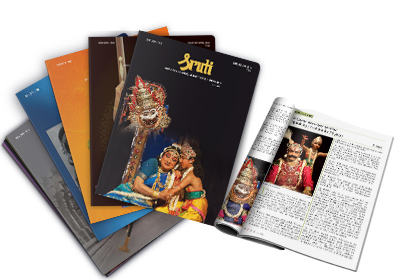
He is an undoubted leader among some of the greatest percussion artists known to the world of classical music. His wizardry on the mridangam has enhanced the quality of Carnatic music cutcheris of at least three generations of artists, and continues to do so with the latest crop of young musicians. He is among the most decorated practitioners of his art, with the Sangita Kalanidhi and the Padma Bhushan the most prestigious honours of his career.
Umayalpuram K Sivaraman was born to Dr P Kasi Viswanatha Iyer and Kamalambal at Kumbakonam, where the family had moved from Umayalpuram, a village in the Kaveri delta and home to several musicians during the 19th and 20th centuries.
A medical doctor, Kasi Viswanatha Iyer counted a number of musicians among his patients and was a vocalist and violinist himself—a disciple of a disciple of Tirukodikaval Krishna Iyer, guru to many greats including nagaswaram maestro TN Rajaratnam Pillai.
The doctor’s residence constantly reverberated with the sound of music, provided by Viswanatha Iyer’s clientele and other musicians. It was hardly surprising that Sivaraman showed a keen interest in music even as a child. The soirees on the balcony of the house had one regular listener in little Sivaraman, whose constant drumming led to his grandmother buying him a khanjira. With his father actively encouraging Sivaraman’s interest in percussion, the boy soon graduated to a bigger instrument in the mridangam.
Sivaraman was unusually fortunate in the way his mridanga career was shaped by parents and circumstances. In time he had four great and illustrious teachers in Arupathi Natesa Iyer, Tanjavur Vaidyanatha Iyer, Palghat Mani Iyer, and Kumbakonam Rangu Iyengar, and enjoyed extensive exposure to the traditional gurukulam system for over 15 years.
Natesa Iyer taught Sivaraman for the first seven years. At age ten, the boy had his arangetram at the Kalahastiswara Swami temple at Kumbakonam, accompanying Srinivasa or Sona Iyengar (vocal) and Vedaranyam Krishnamurthy Iyer (violin). His next guru Tanjavur Vaidyanatha Iyer, the father of the Tanjavur school of mridangam playing, approved the early training Sivaraman had received from Natesa Iyer, and took Sivaraman to new heights of learning, “opening the floodgates of knowledge” in Sivaraman’s own words.
When Vaidyanatha Iyer died in April 1948, Sivaraman was again fortunate enough to be accepted by another great master: Palghat TS Mani Iyer, while a student at the Ramakrishna Mission school at Madras. Sivaraman never forgot his father’s advice that he must be an intelligent listener of music, asking questions and introspecting at once. He observed Mani Iyer’s mridangam playing carefully and internalised his unique strokes and fingering technique. This quality in the young student greatly impressed the teacher who let him return to Kumbakonam with his blessings. Dr Viswanatha Iyer once again made a wise intervention by deputing Sivaraman to Rangu Iyengar of nearby village Saakottai, for advanced training in accompaniment for pallavi rendering.
Sivaraman made steady, even rapid, progress as a concert mridanga vidwan, accompanying many great artists even before he turned 15. The impressive list included the names of Embar Vijayaraghavachari, Sathur Subramaniam, Maharajapuram Viswanatha Iyer, Musiri Subramania Iyer and Madurai Mani Iyer.
Recovering from the big blow of his mother’s death when he was barely 16, Sivaraman resumed training with Palghat Mani Iyer, then living at Tanjavur, but soon moved to Madras following his guru’s advice, to launch his concert career properly.
The move to Madras in 1951 brought not only concert opportunities but also vocal lessons from Kallidaikurichi Mahadeva Bhagavatar and the generosity of several young musicians who sang for him at home to enable him to practise accompaniment. These included PS Narayanaswami, VR Krishnan, Chingleput Ranganathan, AIR Kannan and Palghat Subramania Iyer.
All along, Sivaraman, was gaining a formal education, completing his BA and BL degrees, while expanding his knowledge of music theory under the guidance of another generous soul—Sivasubramaniya Ayya, a violinist who had once accompanied Bangalore Nagaratnammal.
His mind made up by now, Sivaraman focused entirely on his mridangam career, and developing an original new technique that enabled him to the most musical sounds with his instrument, he became one of the most sought after accompanists of all time, arguably the greatest exponent of his art after the Mani Iyer-Palani era.
In his long and distinguished career, he has accompanied almost every artist of note—Ariyakudi, Musiri, Palladam Sanjeeva Rao, Chowdiah, Rajamanickam Pillai, Papa Venkataramiah, Dwaram Venkataswami Naidu, Mudicondan Venkatarama Iyer, GNB, Madurai Mani Iyer, Maharajapuram Viswanatha Iyer and Santhanam, Alathur Brothers, Chembai, Semmangudi, Balamuralikrishna, Nedunuri, Voleti, Balachander, Mali, and almost every young vidwan of today—not to mention some of tomorrow, if we include the number of child prodigies he encourages on stage.
Sivaraman is well known for his research in the art of mridangam, and his lecture demonstrations in India and abroad. He is also a fine teacher in the forefront of propagating the Tanjavur Vaidyanatha Iyer school of percussion. He has written extensively on his art, with special attention to tani avartanam.


